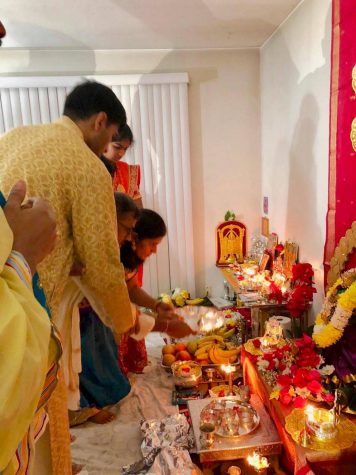Aromas across the world: Incense, bakhoor and xiang bao
Navigating the cultural purposes of fragrant scents
April 2, 2021
Three circle turns during prayer, three wicks, three incense sticks. Miniature statues of Hindu deities, chant books and a bell. Every morning, senior Lakshmi Talapaneni breathes in the light aroma of sandalwood as smoke pirouettes in the adjacent room. Seated on a mat before a small table, her father performs a puja, an act of ceremonial worship that unifies all five senses.
To Talapaneni, the scent of burning incense sticks are a tribute of smell to higher powers — analogous to the religious value of light, a vessel of “positive forces” and goodness.
“[Smell is] an offering to God at the end of the day,” Talapaneni said. “It’s similar to how you offer a light to Him or Her [and] how you offer food — you offer food as well [as] taste, smell, sight. So at the end of the day, when you’re praying, it’s like an offering [to God].”
Talapaneni points out that although incense isn’t a requirement for at-home pujas, it must be present at larger puja socials — such as a satyanarayana puja in holy worship to the god Vishnu — so that all attendees receive the “benefits of the puja.” For Talapaneni, puja groups — a set of people who have come to feel like family for the past seven years — have become a safety net for her.
“If I need anything, somebody in the group will figure it out for me,” Talapaneni said. “My dad hurt his leg a couple weeks ago, and we weren’t able to go to the doctor because of COVID. So somebody from the puja group who was a doctor showed up at our house 12 hours later, and was like, ‘I’m here.’ … That sense of community is super prevalent now because of religion.”
When setting up for a puja, Talapaneni describes that the smell must be “fragrant in a good way,” as a “bad” smell would be interpreted as a room with no scent. Due to this, lighting incense sticks help dispel the air, create a comforting environment and show respect during rituals.

According to Talapaneni, distinct scents can bear noteworthy meanings towards various Indian deities, such as Goddess Lakshmi favoring the lotus flower’s smell. Common incense smells include sandalwood, jasmine, fresh flowers and cinnamon.
Aside from lighting incense to “freshen up [the] mind” and focus during prayer, senior Sowmya Renukuntla’s family uses it during Diwali holiday celebrations, Holi and day-to-day pujas to rid the family of impurity. Renukuntla explains that incense is also practiced as a token of welcoming a family member into the household after marriage, by “taking blessings” from the sticks to “welcome God into your thoughts.” In India, this is practiced in shrines dedicated to specific gods, where thousands of people pass incense sticks around to share and give blessings.
“When we light incense … we like to think [that] … [you] take the smell into yourself,” Renukuntla said. “It’s [a blessing] that you first give it to God, and then you give it to yourself. So it’s like God is blessing it.”
When Renukuntla reminisces about India, three scents come to mind: rose, talcum powder and traffic smog. Renukuntla explains that the scent of rose reminds her of her grandmother who likes to purchase rose-scented Indian products, and talcum powder, the base layer of many types of Indian makeup, evokes memories of her aunts. For Talapaneni, a nostalgic Indian scent is the smell of a yellow ladoo paired with tangy, nut-infused water given after exiting a temple in Tirupati — a city home to a famous temple that attracts Hindu pilgrims year-round.
Junior Jenna Shalluf notes that unlike the correlation between incense and Hinduism, there is no religious meaning behind scents across Middle Eastern cultures. Shalluf describes these smells as long-lasting and strong when worn out of the house, typically having a woody or floral aroma.
“The only thing … that it … promotes [is] cleanliness, and just smelling good,” Shalluf said. “But we do have some plants, like aromatic plants, that are mentioned in our holy book called The Quran, where they’re told that [the plants] have healing abilities. So it’s recommended that we use it if we have a headache or a sore throat, especially olive oil — that’s mentioned a lot. Violet oil is good for headaches. But there’s nothing too holy about it.”

Within Libyan culture, aromatic scents are used on a day-to-day basis, during family parties, special occasions and celebrating holidays, such as Ramadan and Eid al-Fitr. Shalluf attributes the use of incense as a gesture of friendliness, similar to Renukuntla.
“People also use it for hospitality; we have this [scented woodchip] called bakhoor,” Shalluf said. “It’s on this burning [incense] tray, and the host will go around [to] everybody in the room. And they’ll just put it in front of them to give them this smell. It’s just like, ‘You’re welcome here.’”
When Shalluf visited her aunts’ and uncles’ houses in Saudi Arabia, she recalled that her relatives would place incense in the middle of the table to give the room a nice-smelling scent as they converse. Shalluf also recalls the smell of “utur,” an essential oil worn as a perfume and rubbed on the hands, as it brings to mind her grandparents.
Chinese teacher Zoey Liu notes that In Chinese culture, incense is burned for spiritual and nonreligious reasons: for Buddhist meditation, calligraphy writing and repelling mosquitos through sachets. In historical Chinese dramas and films, incense is depicted as an indicator of how much time has passed through the phrase “yi zhu xiang de shi jian” or “the time for an incense stick to burn out.”
Within ancient Chinese aristocracy, incense was recognized as a signature smell for educated citizens to wear on their clothes, as a sign of their intellect and class. According to Liu, this sentiment is denoted by the phrase “san zhu xiang,” where “san” translates to “three,” “zhu” to the measure word for incense sticks and “xiang” to smell.
“Normally when people burn incense, I think for Buddhist belief, people burn three [sticks] because the third one is to pray that you can get wisdom for you to see — to be enlightened,” Liu said. “Just to help you reach peace in your heart, so you can get wiser.”
Liu explains that the sense of smell plays an integral role in Chinese holidays and festivities. On Qing Ming Jie, or the “tomb sweeping day” where Chinese households commemorate past ancestors, incense is respectfully burned as per traditional protocol — along with paper houses and money for deceased family members to receive in the afterlife. On the Dragon Boat Festival, children are gifted “xiang bao” or scented handmade pouches embroidered with colorful silk patterns to hang around their necks. Artemisia, a strong-smelling herb, is hung on front doors to banish ghosts and evil spirits on the Double Ninth Festival.
To Liu, a comfort scent is the smell of her hometown Wuhan’s hot dry noodle — the fragrance of sesame, marinated meat, soy sauce and green onions.
“In the Chinese expression, there’s the phrase called ‘se xiang wei zhu,’ which means for a dish to be really good, you need to have the color, the taste and then the fragrance,” Liu said. “Fragrance is very important when you’re cooking and when you’re enjoying a dish. I think [I am most nostalgic for] the smell of food [that] my family cooks and makes.”



























